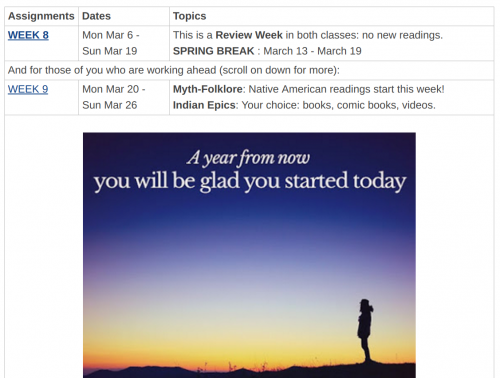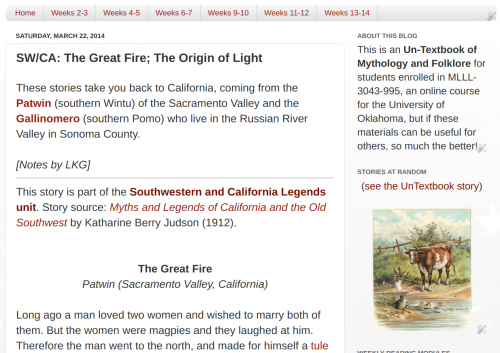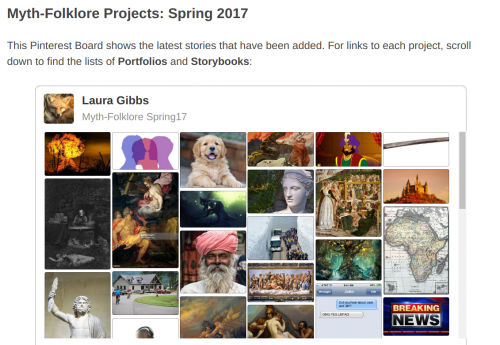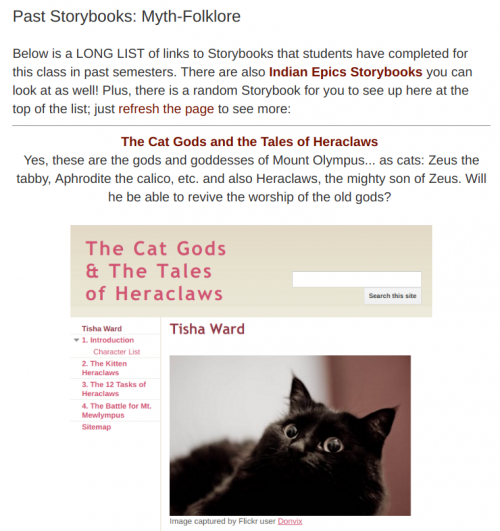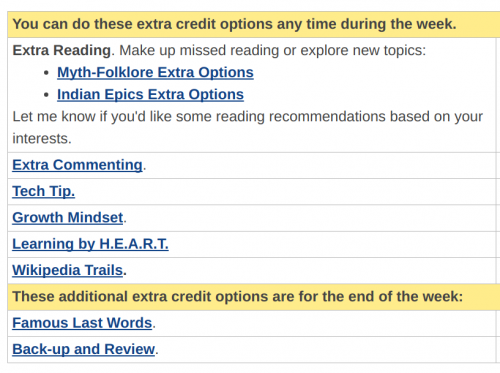I’m attending a video-meeting on Thursday with some people I’ve known for a long (LONG) time and also some people I have not met before; the person organizing the meeting asked me to prepare a quick tour of my courses and how they work.
So, what I decided to do is to create a kind of link-trail that people can follow, stopping out at any point along the way to explore… and then coming back to pick up the trail again. I’ll limit myself to 10 links to keep from things getting too much out of control!
1. Canvas Courses. I teach two courses, and I’ve set them both up as open courses, so you can click and go right there: Myth.MythFolklore.net and Indian.MythFolklore.net. I created those as URLs at my MythFolklore.net domain that I can redirect every semester; my specific Canvas course address changes every semester, but those custom URLs are always good. As you can see, I use a blog as my announcements homepage. My goal is for students to see something new every time they come to the Canvas course space. So, there are new announcements every day, and randomizers in the sidebar too.
2. Class Calendar. In the upper-right box of the announcements blog there’s a link to the Class Calendar; the calendar is the same for both classes. I’m always hoping that students are working ahead in the class, so I created this calendar page with the current week and next week up at the top, a random “time management” meme, and the remaining weeks of the semester down below, plus completed weeks.
3. Weekly Activities. Each week, both classes have the same structure, with six core activities, plus extra credit every week too. The week starts off with reading (the students do two blog posts with their notes, so that’s two assignments), followed by a story post (either writing an actual story, or planning a story that they will write the next week). That’s the first half of the week. Then, in the second half, students work on their projects (either a Portfolio of stories at their blog, or a separate Storybook website), and they also comment on each other’s blog posts and projects. The only difference between the two classes is the reading, so that’s why I am able to use these weekly assignment lists for both classes. Here’s Week 9 for example.
4. Reading. In both classes, the students choose what they want to read. In Myth-Folklore, the readings are all online at our UnTextbook. In Indian Epics, there is a library of free online books plus a fabulous collection of materials on reserve and for checkout in Bizzell. In the Myth-Folklore UnTextbook, there are 100 reading units to choose from, and the students move through different regions week by week; in Week 9 in Myth-Folklore, for example, the readings are from Native American stories.
5. Storytelling. Instead of reading for a quiz or exam, the students are reading to find raw materials for the stories they want to retell. You can see a stream of the story posts and story planning posts from the Myth-Folklore class here, and from Indian Epics here.
6. Projects. Some students collect their favorite story posts into a Portfolio as their semester-long project; other students choose a topic that they work on all semester, creating a Storybook website for the stories they are writing. You can see this semester’s projects for both classes here: Myth-Folklore and Indian Epics.
7. Project Archive. I’ve been teaching my classes this way since back in 2002, and students have been doing projects all that time. Almost all the students leave their Storybooks online after the class is over, for which I am very grateful; the archive of links to past projects is the most important resource in my class for helping the new students each semester to see themselves as writers and to be ambitious about their own projects: eStorybook Central.
8. Comments and Feedback. One of the most important parts of the class is learning both how to give feedback and also how to make use of the feedback you receive. I put the students into blog groups and project groups each week using a randomizing spreadsheet. Thanks to the power of random, the students get to meet and interact with all the other students in the class week by week, and there’s an extra credit commenting option each week too if they want to reconnect with students they have met in past weeks. Here’s what one of the blog comment group pages looks like: Myth-Folklore Week 8.
9. Extra Credit. I use extra credit as a way for students to make up missing assignments. It is also a way for them to do more of what they really like in the class (more reading, more commenting), and there are also some metacognitive and reflection assignments. I am a big believer in the power of growth mindset and other self-awareness strategies, so I like to promote them in the class by means of these extra credit options. Here’s what the range of extra credit looks like each week.
10. Orientation. Okay, I’ll finish by going back around to the start of things: if you want to get started in the same way the students get started, you can begin at the Orientation Week. For the past couple of years I’ve used this Dumbledore meme to get things started…

